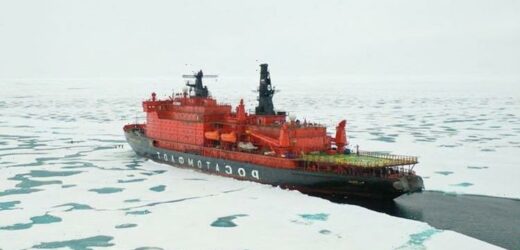COP26: Barack Obama addresses lack of climate change action
We use your sign-up to provide content in ways you’ve consented to and to improve our understanding of you. This may include adverts from us and 3rd parties based on our understanding. You can unsubscribe at any time. More info
Russian media reports indicate at least 24 ships were caught off guard just off the Russian coast, along the risky Northern Sea Route. The shipping route cuts through the polar circle along the Russian Arctic coast where forecasters expected clear passage throughout the month. Recent years have seen the sea route stay open longer than usual as a result of warmer weather and climate change.
Northern Sea Route operators, consequently, believed this year would be no different and were surprised to see ice had already formed across the Laptev Sea and East Siberian sea by late October.
Officials in Moscow have now reportedly launched search and rescue operations, sending two nuclear ice breakers to free vessels stuck in ice up to 11.8 inches (30cm) thick.
There are, however, fears some of the ships could remain grounded for months.
According to the Russian newspaper Vedomosti, an insider at the state-owned nuclear power company Rosatom said “the weather has changed dramatically”.


The source described recent weather reports as “inaccurate” after ship operators were told the route was only covered with “light” snow.
Alexey Likhachev, Director General of Rosatom, was also quoted by Neftegaz, saying the early ice formation was caused by wildfires in Siberia, which he claimed have cooled temperatures in the Arctic.
He also said ice had formed along the route two weeks earlier than predicted for the first time in seven years.
The Neftegaz report indicates that of the 24 trapped ships, eight have already been cleared and sent on their way as of Friday, leaving another 16 to be rescued.
Among the trapped vessels are said to be cargo ships and two oil tankers.
Prince William speaks on climate change at the Foreign Office
The Northern Sea Route serves as a vital connection between Europe Russia and the outside world, as it drastically cuts the amount of time spent at sea.
A ship travelling through the polar circle from northern Europe to Japan, for example, can slash its journey by about two weeks, compared to a trip through the Suez Canal in Egypt.
Operators now fear the delays are going to disrupt vital deliveries of food and other essential goods to the Russian Far East.
The first vessel to ever cross this route only did so in 2017, completing a six-and-a-half day journey.


The LNG tanker, Christophe de Margerie travelled from Norway to South Korea, carrying supplies of natural gas.
Russian President Vladimir Putin congratulated the ship’s crew on their daring adventure, saying: “This is a big event in the opening up of the Arctic.”
The ship’s owners, the Russian firm Sovcomflot, said at the time a fleet of 15 ice-breaking tankers would move through the Northern Sea Route.
Spokesman Bill Spears said: “Previously there was only a window of navigation from our summer to autumn, but this ship will be able to sail westwards from Sabetta which is the Yamal energy port, all year round and eastwards from July to December.
“Before the Northern Sea Route was only open for four months and you had to have ice-breakers – so it’s a significant development.”
However, due to the effects of global warming and melting ice in the Arctic, scientists estimate the sea route will stay open for longer periods.
A 2015 report by the Dutch Bureau for Economic Policy Analysis, for example, said: “A consequence of melting Arctic ice caps is the commercial viability of the Northern Sea Route, connecting North-East Asia with North-Western Europe.
“This will represent a sizeable reduction in shipping distances and a decrease in the average transportation days by around one-third compared to the currently used Southern Sea Route.”
Source: Read Full Article

